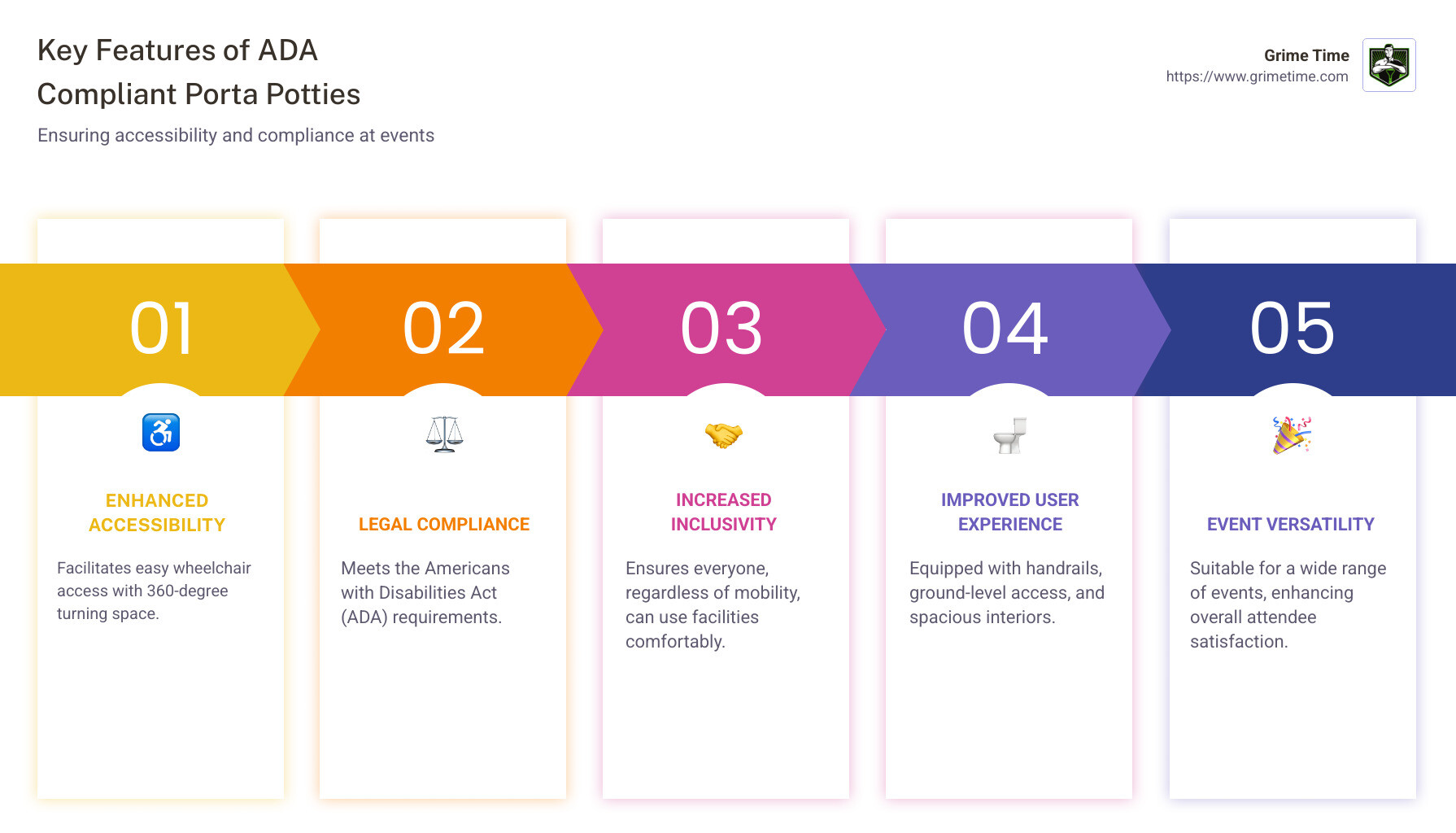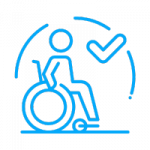Making Events Accessible: Why ADA Compliant Porta Potties Matter
In the field of event planning, there’s a critical factor that too often goes unnoticed: ADA compliant porta potties. If you’re planning an event in Central Texas—from Austin to Buda or San Marcos—making it accessible isn’t just about being inclusive; it’s also about meeting legal guidelines and fostering a welcoming environment for all attendees, including those with mobility challenges.
Here’s a quick overview of what ADA compliant porta potties bring to the table:
- Improved Accessibility: Designed for easy wheelchair access, allowing a 360-degree turn.
- Legal Compliance: Meets the Americans with Disabilities Act (ADA) requirements.
- Increased Inclusivity: Ensures everyone, regardless of mobility, can comfortably use restroom facilities.
- Improved User Experience: Provides handrails, ground-level access, and a spacious interior.
Ensuring your event is accessible is not just an ethical choice; it’s also a business-savvy one. ADA compliant porta potties align with ADA regulations, making sure your event avoids legal pitfalls while embracing everyone.

Understanding ADA Compliance
When planning an event, understanding ADA compliance is essential. It’s not just about ticking boxes; it’s about ensuring everyone feels welcome and can participate fully. Let’s break down what ADA compliance means for portable restrooms.
ADA Regulations
The Americans with Disabilities Act (ADA) sets the standard for accessibility in the U.S. ADA compliant porta potties must meet specific requirements to ensure they are accessible to everyone, including those using wheelchairs. These regulations are more detailed than those for standard handicap-accessible units, emphasizing the necessity for features like wider doors and reinforced construction.
Wheelchair Accessibility
One of the most crucial aspects of ADA compliance is wheelchair accessibility. ADA compliant porta potties are designed to allow a full 360-degree turn, which is a key difference from non-compliant units. This means more space inside, making it easier for users to maneuver. Doors are typically hinged or magnetic, allowing them to close easily, even unassisted.
Legal Requirements
Meeting legal requirements is not optional—it’s a must. The ADA specifies that at least 5% of single-user portable units in a cluster must be accessible. This ensures that events are inclusive and legal. Non-compliance can lead to penalties and negative publicity, which every event planner wants to avoid.

In summary, understanding ADA compliance means recognizing the importance of accessibility features like handrails, spacious interiors, and easy-to-use doors. By meeting these standards, you ensure your event is not only welcoming but also legally sound.
Features of ADA Compliant Porta Potties
When it comes to ADA compliant porta potties, several features are essential to meet the needs of all users, especially those with disabilities. Let’s explore these features:
Handrails
Handrails are a critical component. They provide extra support and stability for users who may need assistance. Mounted on the walls beside and behind the toilet, these grab bars must be sturdy enough to withstand a force of up to 250 lbs. This ensures safety and ease of use for everyone, including those who may have mobility challenges.
360-Degree Turn
One standout feature of ADA compliant porta potties is the spacious interior that allows for a full 360-degree turn. This is crucial for wheelchair users, providing them with enough room to maneuver comfortably. Unlike standard units, this feature ensures that users can easily enter, exit, and position themselves without feeling cramped or restricted.
Ground-Level Access
Accessibility starts at the entrance. ADA compliant porta potties are designed with ground-level access, eliminating the need for a ramp or step. This makes it easy for wheelchair users and others with mobility impairments to enter and exit the unit independently. Ground-level access is a simple yet effective way to improve usability for all.
Spacious Design
The interior of these units is not just about turning space. The overall spacious design accommodates various needs, from wheelchair users to families with small children. This extra space improves comfort and usability, making the porta potty experience much more pleasant for everyone.
Reinforced Construction
Durability matters, especially in high-traffic environments. ADA compliant porta potties are built with reinforced construction to ensure stability and longevity. This robust design means the units can withstand frequent use and various weather conditions, ensuring they remain safe and functional throughout your event.
By incorporating these features, ADA compliant porta potties not only meet legal requirements but also provide a welcoming and accessible environment for all attendees. This attention to detail makes a significant difference in user experience and inclusivity at any event.
Benefits of ADA Compliant Porta Potties
Inclusivity
Ensuring that everyone feels welcome and accommodated is crucial for any successful event. By providing ADA compliant porta potties, you create an inclusive environment where people with disabilities can participate fully. This approach not only demonstrates a commitment to accessibility but also improves the reputation of your event as a welcoming and considerate space for all attendees.
Legal Compliance
Meeting legal requirements is another significant benefit of using ADA compliant porta potties. The Americans with Disabilities Act mandates certain accessibility standards, and failing to comply can lead to legal issues. By ensuring your event meets these standards, you avoid potential fines or lawsuits, making it both a smart and responsible choice.
Improved User Experience
A better user experience is a direct result of the thoughtful design of ADA compliant porta potties. Features like handrails, spacious interiors, and ground-level access make these units easy to use for everyone, not just those with disabilities. When attendees have a pleasant restroom experience, it reflects positively on your event as a whole.
Family-Friendly
Families with young children also benefit from the spacious design of ADA compliant porta potties. The extra room allows parents to comfortably assist their children, whether it’s helping them use the facilities or managing a stroller. This family-friendly aspect ensures that all guests, from the youngest to the oldest, have their needs met.
By choosing ADA compliant porta potties, you’re not just checking a box for accessibility. You’re actively enhancing the experience for all attendees, promoting inclusivity, and ensuring legal compliance—all of which contribute to a successful and memorable event.
ADA Compliant Porta Potties vs. Handicap-Accessible Restrooms
When planning an event, understand the differences between ADA compliant porta potties and handicap-accessible restrooms. While both aim to improve accessibility, they are not the same. Here’s a breakdown of the key differences:
Differences
ADA Requirements
ADA compliant porta potties meet specific standards set by the Americans with Disabilities Act. These standards ensure that individuals with disabilities have equal access to public facilities. Handicap-accessible restrooms, on the other hand, may not meet all ADA requirements. For example, they might have wider doors and ramps for wheelchair access but lack other essential features.
Maneuvering Space
One of the most significant differences is the maneuvering space. ADA compliant porta potties provide enough room for a 360-degree turn in a wheelchair. This is crucial for users who need to move around comfortably inside the unit. Handicap-accessible restrooms may not offer this level of space, limiting their usability for some individuals.
Door Specifications
The door specifications also vary. ADA compliant porta potties feature hinged or magnetic doors that are easier to close, especially for individuals with limited mobility. This is not a requirement for handicap-accessible restrooms, which might have doors that are difficult to manage without assistance.
Why It Matters
Using ADA compliant porta potties ensures that your event is accessible to everyone, including those with disabilities. It also means you’re adhering to legal standards, which can protect you from potential legal issues. It’s not just about meeting the minimum requirements—it’s about providing a welcoming and inclusive environment for all attendees.
By understanding these differences, you can make informed decisions about the facilities you provide at your event. This knowledge helps ensure that all guests, regardless of their mobility needs, have a comfortable and dignified restroom experience.
Frequently Asked Questions about ADA Compliant Porta Potties
What makes a porta potty ADA compliant?
ADA compliant porta potties are designed to meet specific regulations that ensure accessibility for individuals with disabilities. Key features include:
- Handrails: These provide support and stability, making it easier for users to maneuver safely.
- Door Width: The doors are wider than standard units, allowing easy wheelchair access.
- Turning Space: Inside, there’s ample room for a 360-degree wheelchair turn, which is crucial for comfort and mobility.
These elements are not just about convenience; they are legal requirements that help make public spaces more inclusive.
How many ADA compliant porta potties are required at an event?
To comply with legal standards, at least 5% of the portable toilets at an event must be ADA compliant. This ensures that individuals with disabilities have adequate access to restroom facilities. For example, if you’re planning an event with 20 portable toilets, at least one must meet ADA standards.
This requirement is not only about meeting legal obligations but also about demonstrating a commitment to inclusivity and accessibility.
Are ADA compliant porta potties more expensive to rent?
Yes, ADA compliant porta potties typically cost more to rent than standard units. This is due to their larger size and additional features, such as reinforced construction and specialized doors. In Texas, the rental cost can range from $150 to $350 per month, depending on location and duration.

While the initial cost might be higher, the benefits of providing accessible facilities—such as avoiding potential legal issues and creating a welcoming environment—often outweigh the expenses. By choosing ADA compliant units, you’re not just following the law; you’re enhancing the overall experience for all event attendees.
Conclusion
Planning an event in Austin or Central Texas? When it comes to ensuring accessibility, Grime Time is your go-to partner. We understand the importance of providing inclusive solutions, and our ADA compliant porta potties are designed to make your event welcoming for everyone.
By choosing Grime Time, you’re not just renting a porta potty; you’re investing in a seamless event experience. Our units come with essential features like handrails, spacious interiors, and ground-level access, ensuring comfort and ease of use. Plus, our transparent pricing means no hidden fees—what you see is what you get.
Accessibility is not just a legal requirement; it’s a commitment to inclusivity. With Grime Time, you can confidently host events that cater to all guests, including those with disabilities. Our service areas include Austin, Buda, Bastrop, Cedar Park, and many more locations across Central Texas.
Ready to make your event accessible? Contact us today to learn more about our ADA compliant solutions and how we can help you create an inclusive environment for all your attendees.




